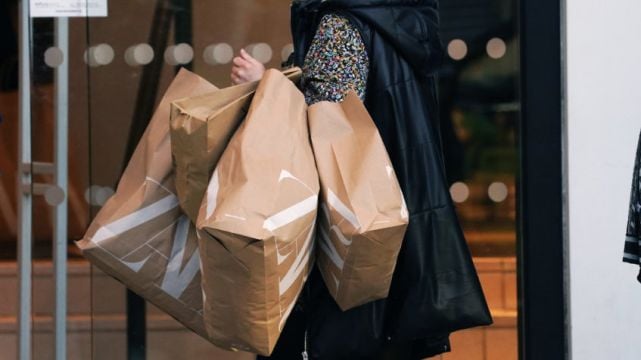Ireland should follow the example being set by France in taking decisive action to address the impact of fast fashion, according to the chair of Charity Retail Ireland.
Mark Sweeney, who is also donated good strategy manager with Oxfam Ireland, says consumption of textiles in Ireland “has massively increased” in recent years.
He adds: “In Ireland, we consume nearly twice as much textiles as some other European nations – just over 50kg of textiles per person, while the average weight in Europe is around 26kg.”
The French legislation to which he is referring is the country’s fast fashion ‘kill bill’, which seeks to place a levy on purchases from fast and ultra-fast fashion giants, like Shein and Temu, and ban the advertising of such products.
Last month, the bill gained unanimous approval in the lower house of the French parliament, and will now pass the Senate for consideration.
Last year, as a nation, we spent €4.5 billion on textiles, which Mark says is largely driven by incessant advertising of fast fashion brands.
View this post on Instagram
“If you go online now, you’re bombarded with fast fashion,” he says. Anyone who has spent even the briefest time online, particularly on social media, will know that to be true.
These ads come in many forms now, some more covert than others, like ‘paid partnership’ and sponsored posts with influencers, coming together to ensure that fast fashion advertising is all but inescapable online.
However, in the fast fashion-laden world of social media, Taz Kelleher has carved out a space for accessible information on sustainability with The Useless Project, which she co-founded alongside Geraldine Carton in 2018.
“Young people and women, in particular, are being sold this idea that they need to have clothing that is up-to-date, that is on trend, they need to have a new outfit for every event,” she says, “and if you do these things it will make you cool, it will make you relevant, it will make you likeable.”
Mark echoes this point, adding that the advertising of fast fashion “taps into that idea that to be accepted you need to have new things”.
This overconsumption is now being heightened further by the speeding up of the trend cycle on social media, the manifestation of which he sees for himself in Oxfam’s charity shops.
“People are buying massive amounts of stuff, not using them, throwing them into a bag, and bringing them to a charity shop.
“Fast fashion items become a very difficult proposition for us to resell, because they were very cheap in the first place, they’re not great quality, so for us to put them out in our shop, we have to sell them cheaper than a fast fashion brand, and that’s not realistic.”
Fashion clothing isn’t some sort of fundamental human right
Due to its availability and affordability, fast fashion has altered consumers’ buying habits, to the point where overconsumption is the norm and hyper-consumption is flaunted by content creators online.
But the impact of these habits rarely hit home for the consumer.
“I think there’s been a bit of a switch in thinking that the rights and wellbeing of the wearers of fast fashion are more important than the rights and wellbeing of the people who are actually making fast fashion,” Taz says.
“We’ve kind of begun to think that fast fashion is some sort of human right, that we should be allowed to have every t-shirt in every colour of the rainbow in our wardrobe for an affordable price, that we should be able to get a new something for every holiday we go on, but fashion clothing isn’t some sort of fundamental human right.”
Mark adds: “If people stopped and looked and thought about how that clothing is produced, what the people who produce them earn, that’s the scary part.
“In some African countries that produce textiles, some people are earning as little as €25 a month.”
In addition to exploitative labour practices, fast fashion is also a sector that causes untold environmental damage.

From the use of unsustainable raw materials, the pollution of waterways during the production process, and textiles often ending up in landfill when they’ve been discarded by the consumer, every stage of the process has a cost for the planet.
“We say it’s terrible that the rivers in Ghana are full of textiles, or it’s terrible that there’s textiles washed up on beaches in Nigeria, or any other country, but we’re the ones causing it because we’re the ones buying those clothes,” Mark says.
He explains that, in Ireland, between 60,000 and 80,000 tonnes of textiles end up in domestic waste each year. From his role with Charity Retail Ireland, he knows this figure eclipses the roughly 18,000 tonnes of clothes sold by the group’s network of around 500 charity shops nationwide.
To solve an issue of this magnitude, there is no silver bullet. If we are to reduce our textile consumption, it will take substantial action from consumers, producers, and policymakers.
In addition to his calls for Ireland to follow in the footsteps of France by cracking down on fast fashion through legislation, he says a focus must also be placed on responsibly and creatively dealing with our textile waste.
Mark highlights the positive work of the Textiles Advisory Group, a subset of the Waste Advisory Group, which brings together stakeholders from across the sector to explore how to minimise textile waste and promote the circular economy.
He adds that investment in methods to repurpose end-of-life textiles would be hugely beneficial in the long term.
Knowledge gap
While the blame cannot squarely land at the feet of the consumers, Taz says there’s a responsibility for us each to come to terms with our relationship with clothing and question why we may feel the need to buy so much.
“People want to do better, but there’s a big knowledge gap,” she says, explaining that the aim of The Useless Project is to narrow that gap with bite-sized information and tips.
Whether it’s through actually wearing the clothes you already have (on average, we only wear around 20-30 per cent of the clothes we own), repairing or restyling items to extend their wear-life, swapping clothes with others, or shopping second-hand, making more sustainable fashion choices needn’t be so hard.
“The alternative doesn’t have to be grey and drab and boring, it can still be fun and colourful and joyous,” Taz says, “it just didn’t have to cost the earth.”
Mark adds: “Consumer behaviour has to change. But for consumer behaviour to change, the producer’s behaviour has to change – as long as people are buying it, they’re going to produce it.”
And while there may be a chicken and egg aspect to this, the solution remains the same: “The only change that can happen is to slow down fashion.”







